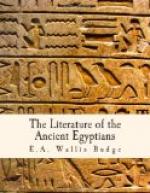[Footnote 1: A form of the Sun-god.]
[Footnote 2: Originally a benevolent god: later the great god of evil.]
[Footnote 3: The scribe of the gods, lord of wisdom: see pp. 1,2.]
[Footnote 4: The Earth-god.]
[Footnote 5: Horus gave his eye to Osiris, and thereby restored life to him.]
[Footnote 6: Repetitions are omitted.]
The next ceremony, the ninth, represented the re-birth of the king, who was personified by a priest. The priest, wrapped in the skin of a bull, lay on a small bed and feigned death. When the chief priest had said, “O my father,” four times, the priest representing the king came forth from the bull’s skin, and sat up; this act symbolized the resurrection of the king in the form of a spirit-body (sahu). The chief priest then asserted that the king was alive, and that he should never be removed, and that he was similar in every way to Horus. The priest personifying the king then put on a special garment, and taking a staff or sceptre in his hand, said, “I love my father and his transformation. I have made my father, I have made a statue of him, a large statue. Horus loveth those who love him.” He then pressed the lips of the statue, and said, “I have come to embrace thee. I am thy son. I am Horus. I have pressed for thee thy mouth.... I am thy beloved son.” The words then said by the chief priest, “I have delivered this mine eye from his mouth, I have cut off his leg,” mean that the king was delivered from the jaws of death, and that a grievous wound had been inflicted on the god of death, i.e. Set.




